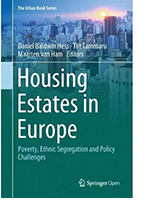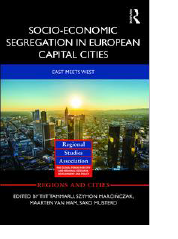 Maarten is Professor of Urban Geography and head of the Department of Urbanism, Delft University of Technology. Maarten is an urban geographer with a background in economic and population geography, and he is a Research Fellow at IZA. In 2014, Maarten was awarded a 2 million Euro ERC Consolidator Grant for a 5-year research project on neighbourhood effects (DEPRIVEDHOODS).
Maarten is Professor of Urban Geography and head of the Department of Urbanism, Delft University of Technology. Maarten is an urban geographer with a background in economic and population geography, and he is a Research Fellow at IZA. In 2014, Maarten was awarded a 2 million Euro ERC Consolidator Grant for a 5-year research project on neighbourhood effects (DEPRIVEDHOODS).

If you are interested in doing a PhD on neighbourhood effects, neighbourhood renewal, neighbourhood change, or residential mobility, or if you are interested in spending research time at TU Delft on a Marie Curie Intra-European Fellowship from the European Commission, please contact me. See also our work on Socio-Economic Segregation in Europe at www.segregationeurope.eu. I am also available for contract Research & Consultancy and lectures.


Edited by Daniel Baldwin Hess, Tiit Tammaru and Maarten van Ham. This open access book explores the formation and socio-spatial trajectories of large housing estates in Europe. Are these estates clustered or scattered? Which social groups originally had access to residential space in housing estates? What is the size, scale and geography of housing estates, their architectural and built environment composition, services and neighbourhood amenities, and metropolitan connectivity? How do housing estates contribute to the urban mosaic of neighborhoods by ethnic and socio-economic status? What types of policies and planning initiatives have been implemented in order to prevent the social downgrading of housing estates? The collection of chapters in this book addresses these questions from a new perspective previously unexplored in scholarly literature. The social aspects of housing estates are thoroughly investigated (including socio-demographic and economic characteristics of current and past inhabitants; ethnicity and segregation patterns; population dynamics; etc.), and the physical composition of housing estates is described in significant detail (including building materials; building form; architectural and landscape design; built environment characteristics; etc.). This book is timely because the recent global economic crisis and Europe’s immigration crisis demand a thorough investigation of the role large housing estates play in poverty and ethnic concentration. Through case studies of housing estates in 14 European centers, the book also identifies policy measures that have been used to address challenges in housing estates throughout Europe.

Edited by Tiit Tammaru, Szymon Marcińczak, Maarten van Ham & Sako Musterd. Growing inequalities in Europe are a major challenge threatening the sustainability of urban communities and the competiveness of European cities. While the levels of socio-economic segregation in European cities are still modest compared to some parts of the world, the poor are increasingly concentrating spatially within capital cities across Europe. This book provides rigorous comparative evidence on socio-economic segregation from 13 European cities: Amsterdam, Athens, Budapest, London, Milan, Madrid, Oslo, Prague, Riga, Stockholm, Tallinn, Vienna and Vilnius. Comparing 2001 and 2011, this multi-factor approach links segregation to four underlying universal structural factors: social inequalities, global city status, welfare regimes and housing systems. Each chapter provides an in-depth and context sensitive discussion of the unique features shaping inequalities and segregation in the case study cities. The main conclusion of the book is that the spatial gap between the poor and the rich is widening in capital cities across Europe, which threatens to harm the social stability of European cities. The INTRODUCTION and CONCLUSIONS are OPEN ACCESS and can be downloaded for FREE.




